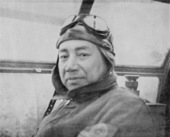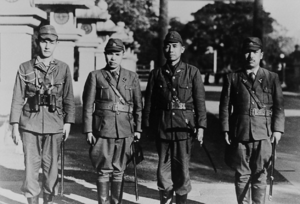Takijirō Ōnishi facts for kids
Quick facts for kids
Takijirō Ōnishi
|
|
|---|---|

Rear Admiral Ōnishi Takijirō (1939-43)
|
|
| Native name |
大西 瀧治郎
|
| Born | 2 June 1891 Tamba, Hyōgo, Japan |
| Died | 16 August 1945 (aged 54) Tokyo, Japan |
| Allegiance | |
| Service/ |
|
| Years of service | 1912–1945 |
| Rank | |
| Commands held | Sasebo Naval Air Group, 2nd Combined Air Group, 1st Combined Air Group, 1st Air Fleet, Vice-chief of Navy General Staff |
| Battles/wars | Second Sino-Japanese War
|
Takijirō Ōnishi (大西 瀧治郎, Ōnishi Takijirō, 2 June 1891 – 16 August 1945) was an admiral in the Imperial Japanese Navy during World War II who came to be known as the father of the kamikaze.
Contents
Early career
Ōnishi was a native of Ashida village (part of present-day Tamba City) in Hyōgo Prefecture. He graduated from the 40th class of the Imperial Japanese Navy Academy, ranked 20 out of a class of 144 cadets in 1912. He served his midshipman term on the cruiser Soya and battlecruiser Tsukuba and after he was commissioned an ensign, he was assigned to the battleship Kawachi.
As a sub-lieutenant, he was assigned to the seaplane tender Wakamiya, and helped develop the Imperial Japanese Navy Air Service in its early stages. He was also dispatched to England and France in 1918, to learn more about the development of combat aircraft and their use in World War I. After his return, he was promoted to lieutenant, and assigned to the Yokosuka Naval Air Group from 1918 to 1920. He continued to serve in various staff positions related to naval aviation through the 1920s, and was also a flight instructor at Kasumigaura.
After his promotion to lieutenant commander, Ōnishi was assigned to the aircraft carrier Hōshō on 10 December 1928 as commander of the carrier air wing. He became executive officer of the aircraft carrier Kaga on 15 November 1932. He was promoted to rear admiral on 15 November 1939 and chief of staff of the 11th Air Fleet.
World War II
Early in the Pacific Campaign of World War II, Ōnishi was the head of the Naval Aviation Development Division in the Ministry of Munitions and was responsible for some of the technical details of the attack on Pearl Harbor in 1941 under the command of Admiral Isoroku Yamamoto. Ōnishi had opposed the attack on the grounds that it would lead to a full-scale war with a foe that had the resources to overpower Japan into an unconditional surrender. Nevertheless, his 11th Air Fleet had a critical role in the operations in attacking American forces in the Philippines from Japanese-occupied Taiwan.
On 1 May 1943, he was promoted to vice admiral. As an admiral, Ōnishi was also very interested in psychology, particularly in relation to soldier's reactions under critical circumstances. In 1938, he had published a book on the subject: War Ethics of the Imperial Navy.
After October 1944, Ōnishi became the commander of the First Air Fleet in the northern Philippines. ..... Following the loss of the Mariana Islands, and facing orders to destroy the US Navy′s aircraft carrier fleet in advance of Operation Sho, Onishi changed his position and ordered the attacks. .....
He addressed the first kamikaze unit and announced that its nobility of spirit would keep the homeland from ruin even in defeat. After his recall to Tokyo, Ōnishi became Vice Chief of the Imperial Japanese Navy General Staff on 19 May 1945.
Just before the end of the war, Ōnishi pushed for continuing the fight and said that the sacrifice of 20 million more Japanese lives would make Japan victorious.
Death
..... Yoshio Kodama was a witness, but subsequently unable to bring himself to commit seppuku. ..... He also stated that he would offer his death as a penance to the kamikaze pilots and their families. Accordingly, he did not use a kaishakunin, the usual second who executes by beheading, and so died of self-inflicted injuries over a period of 15 hours.
The sword with which Ōnishi committed ... is kept at the Yūshūkan Museum in Yasukuni Shrine, in Tokyo. Ōnishi's ashes were divided between two graves: one at the Zen temple of Sōji-ji in Tsurumi, Yokohama, and the other at the public cemetery in the former Ashida Village in Hyōgo Prefecture.
In film
- The Japanese actor Tōru Abe portrayed Ōnishi in the 1970 film Tora! Tora! Tora! (uncredited).
- Ōnishi was also portrayed in the Toei 1970 production Saigo no Tokkōtai (最後の特攻隊, directed by Junya Sato), The Last Kamikaze in English.
- Toei produced a biographical film in 1974, Ā Kessen Kōkūtai (あゝ決戦航空隊, directed by Kōsaku Yamashita), Father of the Kamikaze in English.
See also
 In Spanish: Takijirō Ōnishi para niños
In Spanish: Takijirō Ōnishi para niños




